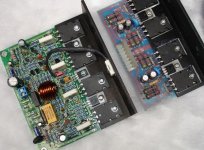Hello and sorry to ask here but I would not start a new thread to ask a simple question :
I use active filtering with 15" JBL loudspeakers (2226H) for the 40hz-400hz part.
I have a Crown K2 amp which I find good but some people claim that its technology is not the best for low frequencies.
Would a Bryston 3B or 4B be appropriate ?
Regards, Greg.
I use active filtering with 15" JBL loudspeakers (2226H) for the 40hz-400hz part.
I have a Crown K2 amp which I find good but some people claim that its technology is not the best for low frequencies.
Would a Bryston 3B or 4B be appropriate ?
Regards, Greg.
t-minus . . .
I did most of the machining of the heatsinks this week, and will be assembling one of the amp board sections fairly soon. I still haven't been able to get reliable info on how to bias the 4B ST, (even emailed bryston). Anyone have a service manual for these amps, or have any experience with how it's supposed to be set? Any info would be greatly appreciated. Thanks in advance!
I did most of the machining of the heatsinks this week, and will be assembling one of the amp board sections fairly soon. I still haven't been able to get reliable info on how to bias the 4B ST, (even emailed bryston). Anyone have a service manual for these amps, or have any experience with how it's supposed to be set? Any info would be greatly appreciated. Thanks in advance!
I did most of the machining of the heatsinks this week, and will be assembling one of the amp board sections fairly soon. I still haven't been able to get reliable info on how to bias the 4B ST, (even emailed bryston). Anyone have a service manual for these amps, or have any experience with how it's supposed to be set? Any info would be greatly appreciated. Thanks in advance!
I know a long time has passed since this last posting, but I was wondering how this went afterwards.
Did you ever finish it?
Did you finally find the info to bias it properly?
If it worked, how did the thermal stability turn out?
Yup, one was completed. Determined the bias values, using the 4B SST service manual as a starting point and adjusting with a scope + distortion meter. Would have to go back into my notes to find the current values I finally settled on.
I'm extremely happy with the performance, clean, detailed and tonnes of headroom. Been running as the L/R in a home theatre for 2 years, no issues with thermal stability have appeared yet.
I'm extremely happy with the performance, clean, detailed and tonnes of headroom. Been running as the L/R in a home theatre for 2 years, no issues with thermal stability have appeared yet.
Yup, one was completed. Determined the bias values, using the 4B SST service manual as a starting point and adjusting with a scope + distortion meter. Would have to go back into my notes to find the current values I finally settled on.
I suspect about 60-65mA per device might be about right.
I've been simulating those and that works well. Plus I think they do mention something like 65mA in their service manuals.
But that's set in more than one step, first at cold room temperature with a lower setting, then let it get warm and correct it again.
The thing is, not everyone has a distortion meter, and some may not even have a scope, and a signal generator...
I'm extremely happy with the performance, clean, detailed and tonnes of headroom. Been running as the L/R in a home theatre for 2 years, no issues with thermal stability have appeared yet.
It may be stable and yet the bias may still have changed somewhat with heat, so perhaps when it's hot the bias could be different from what it was set at first.
This would be interesting to find out. By taking a measurement when it's warm and compare that with the initial setting.
Was the pcb made by copying an original amp? Or was it more loosely based on one but with personal choice and differences?
How are the devices thermally coupled? All on the same sink? What about the 2 sensing devices in the bias spreader? Are they all put together on the same sink? Or is there a separate tracking for drivers and outputs?
That topo is very interesting and has great potential. I don't understand why so many are putting it down.
- Status
- This old topic is closed. If you want to reopen this topic, contact a moderator using the "Report Post" button.
- Home
- Amplifiers
- Solid State
- Bryston 4B ST Clone Started
